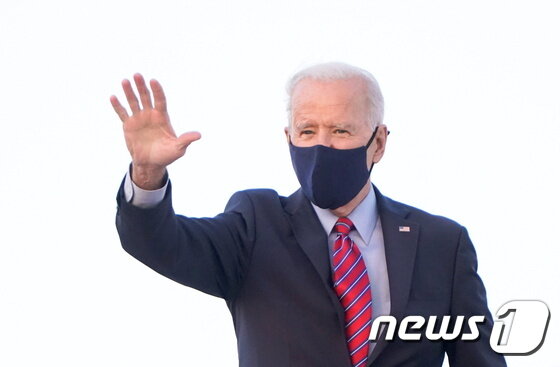 |
| On February 5, 2021 (local time), US President Joe Biden is leaving Washington on Air Force One to spend the weekend in Delaware. © Reuters = News1 © News1 Reporter Park Hyung-ki |
Could the first’Quad Summit’ ever happen?
Joe Biden is attracting attention as it is known that the US government is promoting the summit of a security council quad consisting of four countries, including the United States, Japan, Australia and India. On the 7th, Japanese media such as the Yomiuri Newspaper and the Sankei Shimbun reported that the Biden government is pushing for a quad summit to realize the’free and open India-Pacific keynote’.
However, the’decision of India’, which advocates non-alignment, has emerged as a variable in this meeting. India is burdened with strong checks against China expressed through the quad.
Considering the fact that Quad was launched based on’checking China’s advance into the sea’, the promotion of this summit can be interpreted as the Biden government taking a strong drive to check against China. After taking office, President Biden has not yet made a phone call with Chinese President Xi Jinping.
The Biden government is trying to organize Quad into a multilateral security alliance such as the North Atlantic Treaty Organization (NATO). It is known that the previous Donald Trump administration even planned to make Quad a’Quad Plus’ by adding three countries, including Korea, Vietnam and New Zealand.
The beginning of the quad was initiated to discuss relief aid for the 2004 Great Sumatra Earthquake in Indonesia, which resulted in 220,000 deaths in 13 countries along the Indian Ocean including Southeast Asia and Africa, and was not aimed at China from the beginning.
Later, when Japanese Prime Minister Shinzo Abe visited India in 2007, he was elevated to an informal strategic and security dialogue meeting, arguing the need for an economic and military success against China’s injuries.
Following that, Quad, which was revived by the Donald Trump administration in 2017, held two quad foreign ministers’ meetings in New York, USA in September 2019 and Tokyo, Japan in October 2020.
In this way, the Biden government’s plan is to upgrade Quad, the current foreign ministers meeting, to a summit meeting. The level of pressure on China is also raised by raising the quad’s position.
India seems to be feeling a burden at this point. On the 7th, Sankei cited officials from the Japanese government, saying that the US, Japan, and Australia are positively considering the summit, and that if only India agrees, the talks will proceed. At the same time, India said that it was reluctant to stimulate China and was cautious at previous meetings of foreign ministers.
India has been advocating non-alignment neutralism ever since its founding. The general view is that if the conflict had not intensified due to the bloody conflict with China, the quad would have remained lukewarm. In addition, India’s weapon system is packed with Russia, another rival of the United States.
The ambition to stand as a superpower that is “shoulder-to-shoulder” with the United States rather than an alliance of the United States is also believed to be influencing India’s concerns about quads.
 |
| © News1 Designer Lee Ji-won |
On the 7th, the Global Times, an English version of China’s state-run media, said, “New Delhi is not just an ally of the United States, but aims to become a powerhouse like the United States by becoming a powerful country like the United States.” “Although New Delhi is getting closer to Washington, India’s backbone is still non-alignant,” he said.
On the other hand, SWARAJYA, India’s right-wing monthly magazine, said in October last year, “Quad is a means of foreign policy for India to balance with China through global networking. When it reaches a certain point, the world’s most powerful soldiers It will provide a range of alliances between them.”
On the other hand, Japan and Australia can also express a positive stance to this summit, but if the quad is gradually deepened, it may reveal a burden. At the time of the quad diplomatic ministers’ meeting in October last year, a joint statement was missed. Against this backdrop, it is known that India as well as Japan expressed their position that it is difficult to stimulate China by listening to economic relations with China.
Australia also has a precedent when Australian Prime Minister Kevin Rudd, who took office at the end of the year, for a quad, which had been upgraded to an informal strategic and security dialogue meeting in 2007, declared absence due to concerns over conflict with China. China has also retaliated against the economy, imposing tariffs of up to 200% last year on Australian wines participating in the quad.
In November of last year, Aljazeera said, “China is Australia’s largest trading partner and Japan’s second largest trading partner.” Earlier this month, Tokyo and Canberra signed a comprehensive regional economic partnership agreement (RCEP, Alsep) led by China. Analysts show their willingness to’do business with China’ despite efforts to deter China’s influence.”
Gregory Pauling, director of the US Institute for Strategic and International Affairs (CSIS), cited in Al Jazeera, said, “These competing interests overlap in all China’s attempts to describe the Quad as a US-led’Asiannato’. “It means that it is unlikely that this group will become an official security alliance.”
